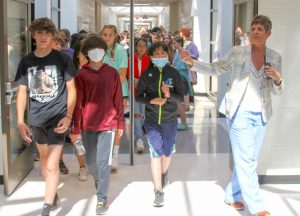Group makes case to Board of Education to convert McIntosh High School to at least be partially powered by the sun
McIntosh High School senior Ted Lord and a group of fellow students attended the May 20 meeting of the Fayette County Board of Education, armed with an abundance of information designed to make the case for converting the school to a solar-powered facility.
Speaking during the public comments portions of the meeting, students Junwei Chang, Jahan Randeria, Robert Palla, Ted Lord, Man Shah, Max Roggermeier and Zack Stone advocated for the conversion.
The three-minute presentations made by each were concise and well-considered. To say they were prepared would be an understatment.
Lord set the stage for the presentation that followed in tandem.
“A unique excellence is cemented in the foundation of McIntosh, which has sparked students to do great things. It is this excellence that has inspired us to think that we can change how our school is powered,” said Lord. “We believe McIntosh can, should and will be solar powered. Our class and those who follow us will have to create a more responsible society powered by sustainable sources of electricity such as the Sun. In fact, nearly 5,500 K-12 schools are now using solar energy.”
“This number of schools will only continue to increase as the cost of solar panels decrease. Because of this school’s energy use, forward-thinking and striving for excellence, we believe McIntosh stands only to gain to transition to solar by covering its roof in panels. This is not energy for McIntosh High School itself, but rather the McIntosh students who grow and learn in this building, and who will soon lead a cleaner and smarter world,” said Lord.
What followed were a variety presentations on why solar is needed and how it could be accomplished, along with costs and savings projections.
Next up was Shah, who spoke about the ecological and educational aspects of solar power.
Shah said solar comes with zero emissions because the panels utilize naturally-occurring sunlight to convert to electricity.
“This also means it is fully self-sustainable. Once set up, the panels generate electricity themselves. No dependency on the grid,” Shah said. “Once demonstrated as clean and feasible, this will promote other solar energy. This begets itself.”
As for the educational aspects of solar, Shah said it ties into the curriculum of all science, math and career and technical education courses.
“McIntosh could lead other schools to solar, including Booth, which can leapfrog into clean energy with its new building having never depended on harmful energy. First day of school, the building can be running on the Sun,” Shah proposed. “McIntosh prides itself on its academic achievements but is depending on energy that is harming our environment. We are not leaders in energy. With McIntosh, and eventually Fayette County going solar, our schools would be well known as an innovative, creative and 21-century thinking schools across the nation. This would spark many other schools to do the same.”
Stone during his comments referenced the financial reasons that solar makes sense for McIntosh.
“If we proceed with this solar initiative, an entire high school could be paying literally nothing for electricity,” he said. “Alternatively, we could stall this project for 10 years, and still be paying significant amounts of money for electricity and be years away from total independence. We have to make the initial investment because essentially, with the availability of panels and the low cost of installation, we are losing money without solar electricity.”
Palla is his comments explained how McIntosh will go solar.
Palla said the school could enter into a power purchase agreement, and work with third-party installers. The agreement would provide for an energy buy-back, he said.
Palla explained that there are a number of grants and incentives available, although the percentages realized are expected to diminish in the coming years.
It was noteworthy that the idea to solar power McIntosh could occur incrementally. Citing examples, Palla said the first phase could include installing solar lights in the parking lots, followed by solar awnings; then moving on, again in phases, using solar to power to provide increasingly larger portions of the school’s energy needs.
Chang in his presentation spoke about the solar installation on the Crowne Plaza hotel facility on Aberdeen Parkway.
“Peachtree City is a great area for solar panel installation due to the vast amount of sunlight the city receives. An example is Crowne Plaza, a hotel located here in Peachtree City that has recently invested $1.1 million in 1,600 LG 400 solar panels. They are expecting to receive their return on investment in roughly 6 to 7 years, which is to say in roughly 6 or 7 years, they will have gotten their initial $1.1 million back in savings,” said Chang.
Chang said the panels are designed to withstand weather and geographic imperfections and have a lifetime of 25 years.
“The panels themselves are stationary and face southwest as the Sun crosses through the sky from the south and towards the west. Crowne Plaza does not have batteries to store their solar electricity,” Chang said. “The hotel uses software that tracks the amount of energy generated using the panels and how much fuel they have saved and carbon dioxide emissions they have reduced. Also, minimal vegetation was removed since the solar panels are installed on the roofs of the building.”
Randeria tackled the cost and savings aspects of the project.
“In the 2017-2018 school year, McIntosh alone ended up using a grand total of 2.76 million kilowatt hours worth of electricity. This amounted to about $475,000, a significant cost for the county. A switch to solar would significantly offset these costs for the school,” Randeria said.
Also referencing the solar installation at Crowne Plaza, Randeria said the hotel uses panels that are extremely efficient.
“If we use this panel type, the high surface area of McIntosh’s roof easily offsets the minor efficiency reduction,” Randeria noted. “To install this panel, we estimate that a total of $2.67 million is required. Distributing this expense over two years sets the yearly cost at $1.355 million. For three years, $890,000 dollars. For five years, $530,000 dollars. With the use of a purchase power agreement, there would be little upfront cost. We expect a return on investment time of about 5.6 years. The savings from the reduced electricity expense could allow a larger proportion of the budget to be allocated towards expenses such as textbooks, better pay for teachers, better science labs and other (benefits).”
Roggermeier wrapped up the presentation, again making the case for a solar-powered McIntosh High School.
“McIntosh is a school that demands excellence: excellence in its students, its teachers, its administration and its community. We have gained support from all of these groups. We have released an online survey, gaining responses from hundreds of students and members of the community, with a nearly 96 percent approval rating for solar energy in school buildings,” Roggermeier said. “We’ve gotten signatures from teachers and staff on a petition to integrate solar energy, and even received support from our own principal, Dr. Lane.”
Roggermeier then posed a question for board members to consider.
“What do you want McIntosh to be? What do you want to be?” he asked. “We want to be excellent. We can be excellent. The technology is there, it is just a matter of putting it into place. If not for the educational opportunities, if not for the environmental benefits, if not for the economic savings, then do it for this – the McIntosh I see. Not the McIntosh (of today), with its power outages and echoey senior cafeteria, but McIntosh the way it can be, the way I know you want it to be. A McIntosh that leads and inspires its students to be creative and innovate, and be passionate, and work hard to change their world for the better. Do it for that. It is here and it is now, and it is possible, and I know we can do it.”
The school board customarily does not respond to public comments. That said, it will be no surprise if the conversation dealing with McIntosh and solar power continues.
Those interested in the project can find out more on social media can locate this group of inspired students at #SolarForMcIntosh.













Leave a Comment
You must be logged in to post a comment.